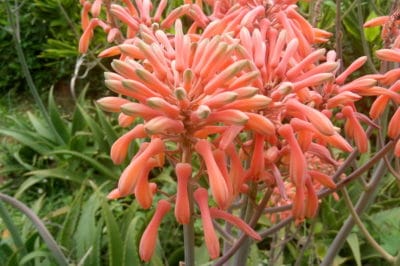The Flowers
Aloe blooms are impressive, with a single stalk on which a cluster of tubular flowers rises over the spiny leaves. The individual flowers are long and narrow, typically in shades of bright yellow, orange or coral. Although many people say the plant itself has a scent, the flowers have no noticeable scent. In the wild, the plant is pollinated by insects and birds attracted to the flowers.
Growing Aloe Vera
Mature, healthy aloe vera plants are most likely to bloom. The plant must be at least four years old. Outdoors, aloe vera is most likely to bloom in summer, but it may bloom sporadically at other times of the year in some areas. Indoors, aloe vera plants are more likely to bloom in late winter or early spring. They are not usually used in flower arrangements.
To Encourage Blooming
Mature aloe vera plants are more likely to bloom under these conditions:
- The plant is in a brightly-lit window (no shade from trees) that faces south.
- Daytime temperatures are between 70°F (21°C) to 85°F (29°C); nighttime temperatures no lower than 60°F (15°C).
- The room has good air circulation.
- The plant is grown in the right soil, watered correctly and fertilized regularly with 10-40-10 NPK liquid fertilizer.
Pups and Repotting
Pups, or offsets, are new plants that grow around the base of the mother plant. A plant that is producing pups is less likely to bloom because it doesn’t have the extra energy. In the fall, cut off the pups with a sharp knife, let dry for about 24 hours and plant them in pots of their own. Repot the mother plant in a new pot about three times wider.
Watering and Bloom
Although aloe vera is a desert species, it will usually not bloom indoors without sufficient water. Make sure your potting soil drains well, however, to prevent root rot. Water from the top and soak the soil any time the top inch of soil in the pot is dry. To fertilize, water first, and the water again with dilute liquid fertilizer solution. Decrease water in winter.
